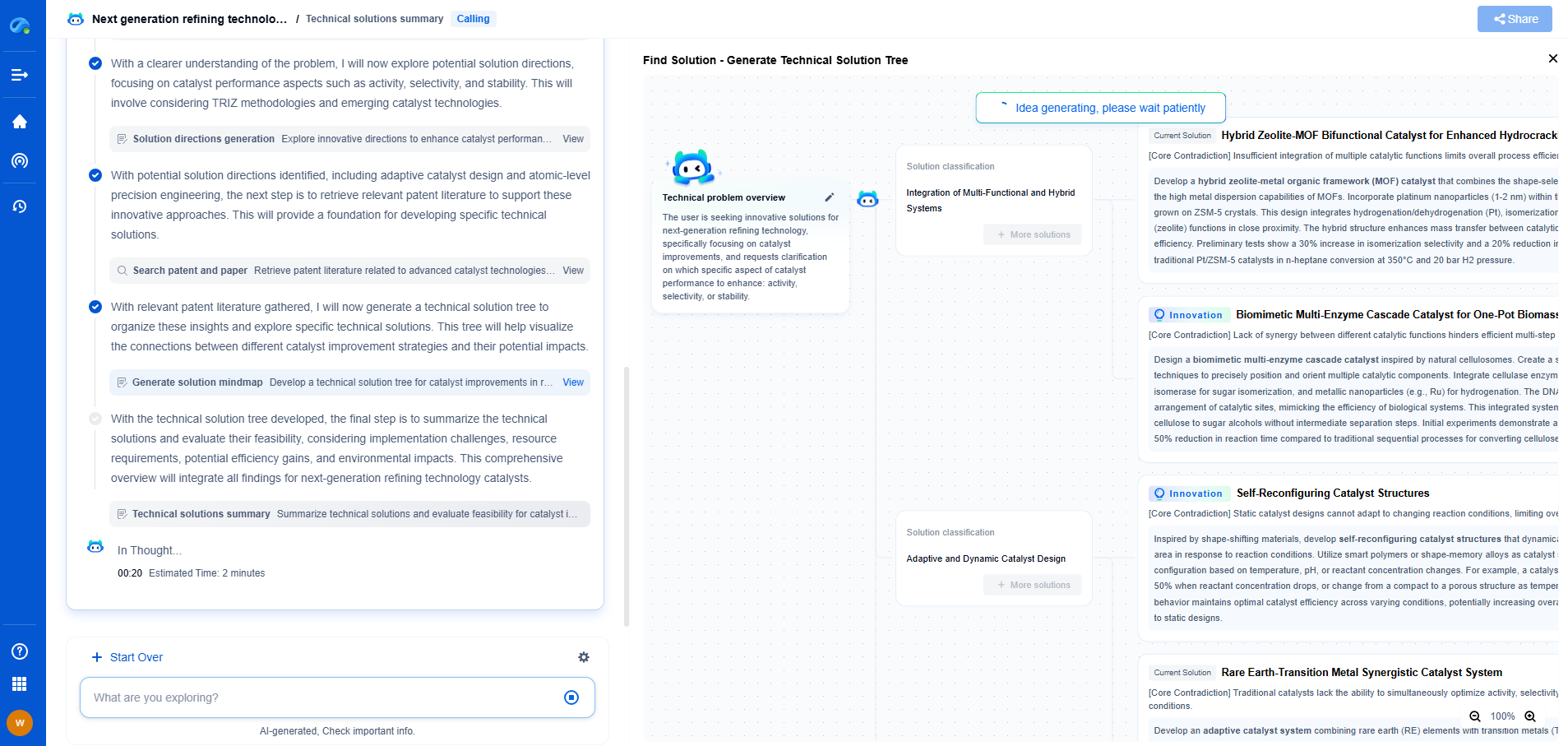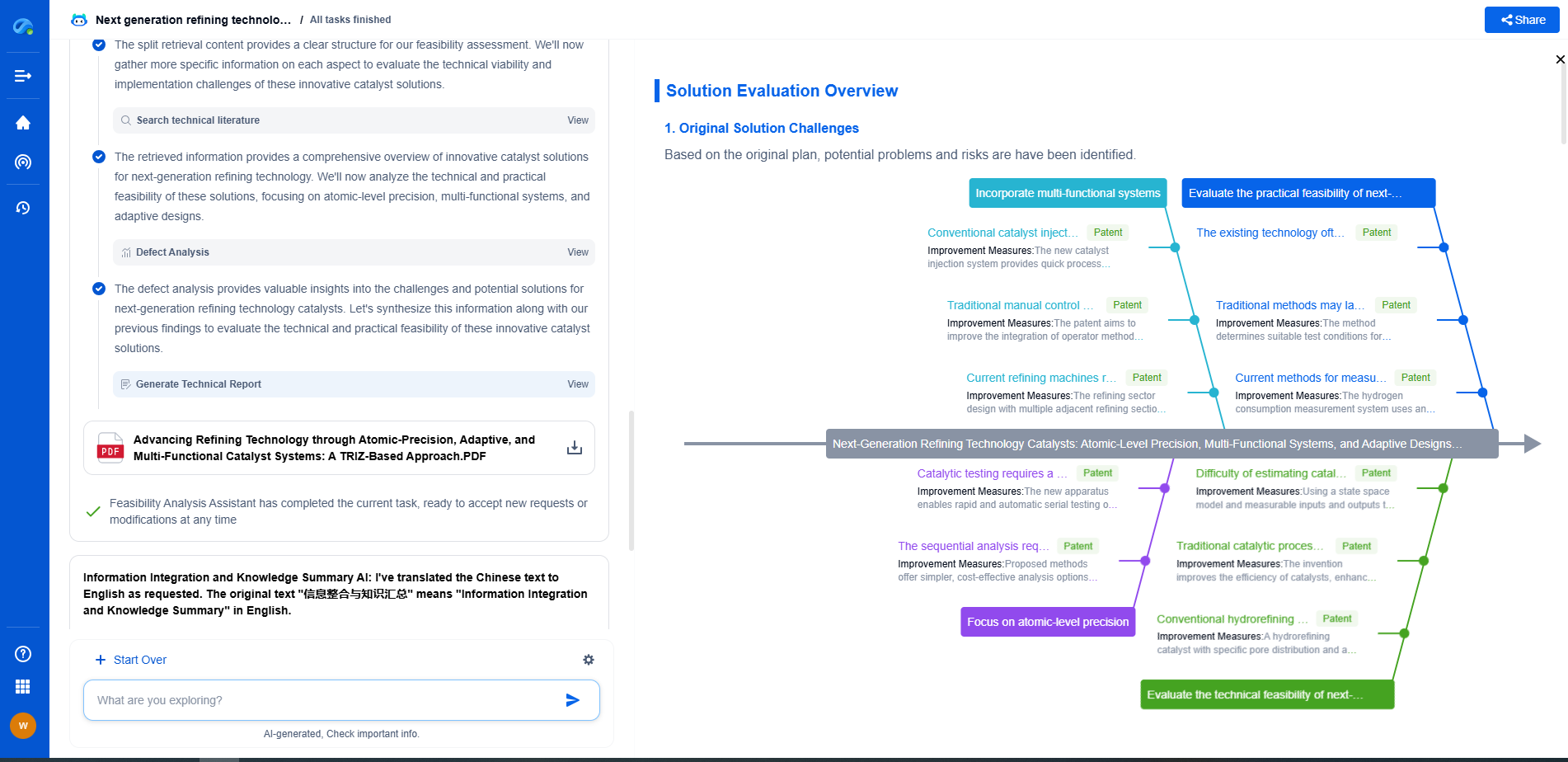How to Monitor Pipeline Pressure and Flow Rates in Real Time
JUN 20, 2025 |
The monitoring of pipeline pressure and flow rates is a critical task in various industries, including oil and gas, water supply, and manufacturing. Real-time monitoring helps prevent leaks, ensures efficient operation, and mitigates potential hazards. This blog post delves into the methods and technologies available for real-time monitoring of pipeline pressure and flow rates, providing practical insights for effective implementation.
Understanding the Basics of Pipeline Monitoring
Pipeline systems are complex and often span vast areas, making manual monitoring impractical. Real-time monitoring systems are designed to provide instant data and alerts regarding the pipeline's status. The two key parameters that need constant monitoring are pressure and flow rates. Pressure monitoring ensures the integrity of the pipeline, while flow rate monitoring helps in assessing the efficiency and functionality of the system.
Technologies for Real-Time Monitoring
Several technologies are employed to monitor pipeline pressure and flow rates in real time. These include:
1. **Pressure Sensors**: These devices measure the internal pressure of the pipeline. Modern sensors are capable of transmitting data wirelessly to a central monitoring system, providing real-time updates.
2. **Flow Meters**: These instruments measure the flow rate of the fluid within the pipeline. Flow meters come in various types, such as ultrasonic, electromagnetic, and turbine meters, each suitable for different kinds of fluids and pipeline conditions.
3. **SCADA Systems**: Supervisory Control and Data Acquisition (SCADA) systems integrate data from sensors and meters across the pipeline network, providing comprehensive monitoring and control capabilities. SCADA systems can analyze data in real time, triggering alarms and even automatic shutdowns in case of anomalies.
4. **IoT and Wireless Communication**: The Internet of Things (IoT) has revolutionized pipeline monitoring by enabling sensors and devices to communicate over wireless networks. This infrastructure facilitates the remote monitoring of pipelines, reducing the need for physical inspections.
Implementing a Real-Time Monitoring System
Successful implementation of a real-time monitoring system involves several steps:
1. **Assessing Pipeline Requirements**: Every pipeline system has unique characteristics. Conduct a thorough assessment to determine the specific requirements for pressure and flow monitoring.
2. **Selecting Appropriate Technologies**: Based on the assessment, choose suitable sensors, flow meters, and communication technologies. Consider factors such as the type of fluid, pipeline material, and environmental conditions.
3. **Integrating Monitoring Systems**: Ensure that all components, such as sensors, meters, and SCADA systems, are properly integrated and can communicate seamlessly. This may involve setting up network infrastructures and establishing data protocols.
4. **Data Analysis and Response Strategies**: Develop strategies for analyzing the data collected from the monitoring system. Implement automated response procedures for different scenarios, such as pressure drops or flow rate anomalies.
Benefits of Real-Time Monitoring
Real-time monitoring of pipeline pressure and flow rates offers numerous benefits:
1. **Enhanced Safety**: Immediate identification of leaks or pressure anomalies helps in preventing accidents and environmental damage.
2. **Increased Efficiency**: By monitoring flow rates, operators can optimize the operation of the pipeline, reducing energy consumption and improving throughput.
3. **Proactive Maintenance**: Real-time data allows for the early detection of potential issues, facilitating timely maintenance and reducing downtime.
4. **Regulatory Compliance**: Many industries are subject to strict regulations regarding pipeline operation. Real-time monitoring helps ensure compliance by providing accurate and timely data.
Challenges and Considerations
While real-time monitoring offers numerous advantages, it also presents challenges:
1. **Initial Setup Costs**: The installation of sensors, communication systems, and SCADA infrastructure can be costly.
2. **Data Management**: The volume of data generated by real-time monitoring systems can be overwhelming. Effective data management solutions are essential.
3. **Security Risks**: Wireless communication systems are susceptible to cyber threats. Implement robust cybersecurity measures to protect sensitive data.
Conclusion
Monitoring pipeline pressure and flow rates in real time is an essential practice for ensuring the safe and efficient operation of pipeline systems. By leveraging modern technologies such as sensors, flow meters, and IoT devices, industries can achieve greater control and insight into their pipeline operations. While there are challenges to be addressed, the benefits of enhanced safety, efficiency, and compliance make real-time monitoring a worthwhile investment. As technology continues to evolve, the capabilities of real-time monitoring systems will only expand, offering even more sophisticated solutions to pipeline management challenges.
Transform the Way You Innovate in Pipeline Technology—with AI-Powered Intelligence
From corrosion-resistant materials to smart monitoring systems and advanced flow control mechanisms, the pipeline industry is undergoing rapid technological transformation. Yet keeping up with evolving engineering solutions, regulatory landscapes, and competitive patents can be a major bottleneck for R&D and IP teams.
Patsnap Eureka is your AI-powered research companion—built specifically for professionals in high-tech and infrastructure domains like pipeline technology. Whether you're designing high-pressure transport systems, assessing trenchless installation innovations, or safeguarding proprietary flow assurance solutions, Eureka provides real-time insights into global patent trends, emerging technologies, and R&D intelligence—all in one intuitive interface.
Empower your team to innovate faster, reduce technical blind spots, and stay ahead of industry shifts. Discover Patsnap Eureka today and bring clarity and confidence to your pipeline technology decisions.
- R&D
- Intellectual Property
- Life Sciences
- Materials
- Tech Scout
- Unparalleled Data Quality
- Higher Quality Content
- 60% Fewer Hallucinations
Browse by: Latest US Patents, China's latest patents, Technical Efficacy Thesaurus, Application Domain, Technology Topic, Popular Technical Reports.
© 2025 PatSnap. All rights reserved.Legal|Privacy policy|Modern Slavery Act Transparency Statement|Sitemap|About US| Contact US: help@patsnap.com

